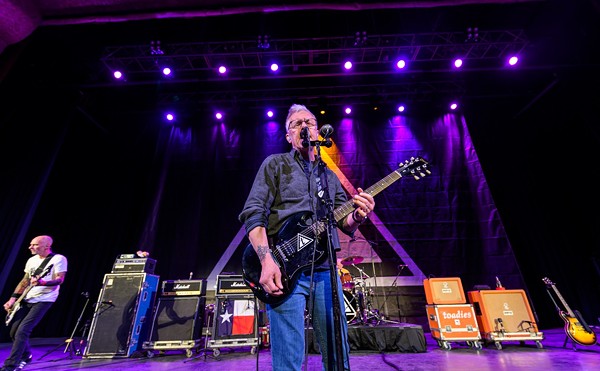Priscilla Treviño Lozano left San Antonio 33 years ago and never looked back. She sporadically but regularly kept in touch with her family, but only visited on a couple of occasions. For the most part, she devoted herself fully to her mission: to live, breath, dance, and teach flamenco in Granada's historic Sacromonte neighborhood, one of the main hearts and breeding grounds of gypsy Spain.
Named "La Presy" (a rendition of "La Prisci," as she was known in San Antonio) by legendary singer-dancer-actress Lola La Faraona (Lola Flores, 1923-1995), she died penniless on December 25, 2011 at the age of 59, but only after becoming one of the most respected flamenco teachers in Granada.
Instead of the usual dresses, her signature look was pants (as inspired by the great Carmen Amaya), white shirt, and black vest. She was an aggressive dancer who worked in the U.S., Spain, France, Italy, and Switzerland, and her intense style resembled that of bailaor (dancer) Manolete, the man who convinced her to stay in Spain.
A little over a year after her death, La Presy's work is beginning to pay off: two of her best and closest students, Lara Bello and Patricia Guerrero, are traveling the world sharing the art they began learning with her.
Directly or indirectly, most San Antonio flamenco schools are related to La Presy, whose legacy is also a vindication for the work of a local scene often dismissed in favor of "the real flamencos from Spain." Yet, very few people know of La Presy in the Alamo City.
"Because she left and was in Spain for so long, everybody here forgot who she was," said Chayito Champion, the daughter of Teresa Champion (La Presy's first flamenco teacher) and the late El Curro, Texas' premier flamenco guitarist. "'Prisci' here was never recognized and that's a shame, because she touched a lot of lives here, too."
This is her story.
"LA PRISCI"
"She had a wooden platform under the bed, and she'd step on it and dance for hours in front of a big mirror," said older sister Gladys Donovan in her house in the Southwest side of SA, the same house where Priscilla grew up. From an early age, Priscilla — born April 1, 1952 — showed interest in dancing. As a child she studied tap dancing and acting, but in 1966 she discovered flamenco and her life changed forever.
She was part of the glorious generation of top-notch SA dancers that includes Timo Lozano (now teaching in Houston), Esmeralda and Carla Enrique (now in Toronto), Jesús Moreno, and Manolo Valente (both in San Antonio), who started with Teresa Champion and then went on to tour nationally and eventually spent time in Spain. But La Presy was special.
For Sylvia Castillo Davis, who met La Presy when they were both students at James Rusell Lowell Jr. High School, the memory of her talent is still vivid.
"She had the confidence and the acting skills to walk anywhere and say I'M HERE," said Davis. "All she had to do was dance. That was enough for everyone to sit down and shut up."
Early dancing partner and eventual boyfriend Manolo Valente claims to have taught La Presy her first basic footwork (zapateado).
"I'm the one who didn't want to teach her, but she was very persistent and kept asking me," said Valente, who spent three years as a member of the company of legendary El Greco (José Greco, an influential Italian-American dancer and choreographer who died in 2000). Valente taught her some basic zapateado and asked her to practice for "two to four weeks." Two weeks later, La Presy called back.
"I went to see her and I was spellbound," said Valente. "Her feet were like machine guns, I couldn't believe it. She had learned everything. Those feet spoke to you. She had the unbelievable gift of a photographic memory."
But if Valente taught her the basics, it was Teresa Champion (El Curro's wife) who became La Presy's first full-time flamenco teacher. As was the case with every person interviewed for this story (both here and in Spain), Teresa Champion is still amazed by La Presy's capacity to absorb information.
"She was very good as a girl and incredibly talented as a dancer," Teresa Champion said. "It was as if she had a photo camera in her brain. We would teach her a step, and she'd never forget it."
Between the late '60s and early '70s, La Presy danced regularly in San Antonio at places like Six Flags, the Arneson Theater, and El Poco Loco on North Presa. In 1973, she joined the Ciro company in New Orleans' Chateau Flamenco (Ciro Diezhandino being a world-renowned U.S.-based Spanish dancer and choreographer). She began receiving offers to dance around the country; her career was on the rise. Then, tragedy struck.
The accident
On Easter Day in 1975, on the night she would replace dancer Morayma Muñoz at a show at New York's Chateau Madrid, the cab they were riding in was hit head-on and both Muñoz and La Presy flew out the back window. Muñoz died at the scene and La Presy was sent to Bellevue Hospital.
"[La Presy's] heart stopped at the emergency room a couple of times and she had to be revived," said sister Gladys Donovan. "She was told she could never dance or walk properly again," said Gladys.
But La Presy was tough and wouldn't take no for an answer. A year after the accident she was dancing again, and in 1979 she visited Granada, Spain. She fell in love with the place, returned briefly to the States, and then she was gone. Only this time, her look changed.
"After the accident, she started wearing pants [to hide the scars from the accident]," said Josie Champion. "She never wore dresses or skirts again. A very powerful feminine/masculine look."
"Nobody wanted her to go and live there by herself, but she was headstrong and that's what she wanted to do," said Debra Archuleta, her niece.
In the early '80s, La Presy in Granada was like a fish in the water. Right from the start, she was able to blend in — she had the chops, and she had the looks. Her family confirmed the fact that she had some Comanche Indian blood in her, but not nearly as much as she claimed.
"She said she was a full-blooded Comanche Indian," said Nacho Martín, director of the prestigious Granada's Carmen de las Cuevas academy, where La Presy taught from 1996 to 2000. "She had the blackest of hairs, the facial features. She had a very authentic racial look.
Everyone thought she was a gypsy."
Juan Pinilla, a well-known flamenco cantaor (singer), scholar, and journalist from Granada, shed further light on the significance of La Presy's acceptance among the gypsies.
"In flamenco, the most difficult thing to achieve is the acceptance of Andalusian gypsies," said Pinilla. Though flamenco has developed in Andalusia from a blend of cultures, including the Moors and other many peoples who have lived in Spain, it is widely accepted that it is a gitano thing. "The gypsies think they own it and discriminate against Castilian artists. But La Presy was considered a gypsy by the gypsies, which is a badge of honor only reserved for high-quality [performers]."
Renowned bailaor Manolete met La Presy "about 30 years ago," when he spotted her dancing at a Granada hall named El Neptuno.
"Hey, what are you doing in Granada? You're dancing very well," Manolete told her. "I suggested she should stay in Granada." La Presy could not have agreed more.
But at that point La Presy wasn't the full-fledged flamenco powerhouse she would become later. Because she came from a classical and tap school, her body and arms were different, and she was overdoing her footwork.
"She had to adapt her body and understand that, if you do everything with your feet … well, you'll get too many calluses," Manolete said. "She was able to adapt and her transition was successful."
La Presy only took a handful of classes and workshops with Manolete, but she made them last.
"She was like a sponge," Manolete said. "She'd pick up the music and the steps quickly, store them in her little head, and practice on her own. She never forgot anything. And that's why her style always resembled mine. She could dance as well as anybody else and could've achieved more as a dancer. But she chose to stay [in Granada as a teacher] and was very strong at Sacromonte."
In 1985 she gave classes to 50 gypsy children as part of an official minority campaign by the City of Granada, and in 1989 she presented her first choreography in Granada, a three-act ballet based on One Thousand and One Nights. She danced in France, Italy, Greece, and Switzerland, and in 1997 she taught at the Peña La Platería, the world's oldest flamenco association.
As her reputation grew, more and more dancers wanted to dance with her. She left Carmen de las Cuevas to open her own school in one of Sacromonte's cuevas (caves). While most flamenco stars made their career in Madrid and Seville, La Presy stayed in Granada.
"Only Mariquilla [María Guardia], La Presy, and a handful of others were able to establish themselves in Granada," said Nacho Martín, from Carmen de las Cuevas. "She was a key figure because she was a great teacher, especially when it came to classic flamenco basics. She came from the Ciro school, which is a very important one."
Her classes were grueling. La Presy had no time for those who wanted to have an "extracurricular activity." She wanted serious (and good) dancers. Many left, intimidated by her demanding nature and fierce personality. If you were her dancer, she had no problem telling you exactly how you were supposed to do that step.
"I don't see too many virgins in here," she used to tell her students during any of her legendary class interruptions. "¡Tienes que mover las caderas como si te estuvieran comiendo el coño!" ("You have to move your hips as if someone was eating your pussy!")
"She was wild, lethal, but she was also very funny," said singer-songwriter-dancer Lara Bello, who studied under her since the late '90s. "She would find things in you other schools couldn't find, because she was fearless. She didn't care about what people may have thought of her — all she cared about was for you to learn that step, and was willing to say anything to make you understand."
Home is where the heart is
In 1998, when her mother got very sick, La Presy returned to San Antonio for a few weeks. She did a few workshops at Teresa Champion's studio (then located on Flores St.) and then, in 2000, Josie Champion (El Curro's sister) brought her back to do workshops 18 hours a week for at least three months.
"She gave an extraordinary workshop," said Carmen Linares "La Chiqui," one of SA's top flamenco instructors. "When Josie brought her I sent about 20 of my students. It was very strong."
"As a teacher myself, I was flabbergasted when I saw that workshop," said Jesús Moreno, who toured with La Presy when they were with the Ciro company in the early-to-mid '70s. "She was amazing. One thing is to teach, but to go from dancer in SA to teacher, and then teach Spaniards, that's something else." And yes, Moreno also praised La Presy's unique gift: "She had a photographic memory."
"I was giving her a way to make money before going back to Spain," Josie Champion said. "We fed her, we clothed her, put 15 pounds on her. She brought Spain to us and left me with enough flamenco material to last me for a lifetime."
Both Teresa and Josie Champion admit much of the choreographies they use to this day are La Presy's.
"Bringing her here was very special for me because she's one of my greatest influences," said Josie. "I learned flamenco with my family and my style reflects that. I love my family very much and Teresa means the world to me, but I do my own thing and my compases [plural for compás, or the intricate time signatures of flamenco], are all La Presy's. She's the one I looked up to and the one I wanted to be like."
Once back in Spain, La Presy kept busy. She taught at Carmen de las Cuevas for four years before finally opening her own school in 2000.
Going down
When La Presy's family met with the Current for this story, an undated postcard was found among La Presy's memorabilia.
"Except for my visit home and other few outings, it's been a year to forget," wrote La Presy in the postcard. "There's a lot to confide but things are in limbo for me at this minute. I'm surviving and underweight … There are times I need yous [sic] and mom so much."
Gladys Donovan (La Presy's sister) and Debra Archuleta (niece) believe La Presy brought the postcard herself in either one of her two visits in 1998 and 2000.
"For some reason, she didn't mail it," said Debra. "But she left it here."
Whatever her problem was, La Presy kept on pushing with her classes until her body started to give in.
In 2008, in the middle of one of her classes, she experienced trouble breathing and asked one of her students to call an ambulance. She was admitted to the hospital with "chronic respiratory problems," according to Ángel Horcajadas, one of the doctors who saw her. "She took very little care of herself," said Horcajadas. "She smoked a lot and was in very bad shape. She only went to the doctor when it was too late. The impression that I got is that she lived in her own world and never listened to anyone else."
After that first visit to the hospital in 2008, she needed oxygen at all times. Nevertheless, she seemed in good spirits when Archuleta and Donovan visited her in Granada on separate occasions in 2009. For some reason, La Presy had asked Archuleta to call and she would come get them. "Don't just show up," she had told them. But Archuleta's husband, Bryan, insisted on "giving her a surprise."
When they arrived at La Presy's house, Archuleta froze.
"I just couldn't ring the bell," Archuleta said. "On the one hand I was happy to see her again, but on the other hand I was afraid she'd start yelling at me for showing up."
So she called her mother Gladys in the U.S., and Gladys called La Presy, who let them in. It was a happy encounter, but La Presy soon showed that taking care of herself wasn't one of her priorities.
"She was supposed to have her oxygen tank with her at all times, but never used it," said Archuleta. "She didn't want to be seen with that."
La Presy took Debra and her husband everywhere. Restaurant owners would show their respect for La Presy, but when it was time to come back to resume her classes, La Presy was exhausted.
"She'd say, 'Just give me a couple of hours to rest,'" Archuleta said. "All the walking, coupled with the classes, took everything she had."
In 2010 the doctors found an aneurysm, and she quickly deteriorated.
"She could be discharged in few days … Her problem is only a speech one," Dr. Horcajadas wrote the family on August 3, 2010. "She has a difficult aneurysm to operate on and unfortunately she suffered a vasospasm after surgery, affecting [the] left side. She hasn't motor deficits, so she can walk and take care of herself, but she has problems to communicate (not to understand)."
On October 2010, La Presy (who, when healthy, was "a wonderful writer," according to Archuleta) sent a somber letter that reflected the effects of her condition. In retrospect, it now reads as if she knew her days were numbered.
"I can feel very negative with my life and there has been many priceless errors," she wrote. "(…) Right now I'm so afraid of my future. I traveled out of Texas and dreaming of all I could have. I've never [had] fear of dancing. To me it was something I felt very sure, and all the dreams and achievements have been glorious for all the doubts that I had. For my disdain for me, I can say my life has been so well for me."
"The last time we spoke on the phone she couldn't recognize me," said Alfredo Mesa Martínez, one of her guitarists. "All she could tell me is that she was very scared of what the doctors told her."
Unexpected help
Because she was a proud woman, few knew the real extent of her illness. Her health was quickly worsening and she had no one to take care of her. No one, except Tony.
Antonio Rubio Delgado was La Presy's on-and-off lover for about 20 years. Some say he was an artist, but by all accounts their relationship was highly dysfunctional.
"She told us that he had mistreated her and got her into drugs," one source said. "And we all believed her. I first saw her at the Peña [Flamenca de] la Platería [the world's oldest existing flamenco club, in Granada] in 2000 and she looked like someone you would say, 'Oh, she's a drug addict.' But after they broke up, she was her usual self."
It took therapy for her to finally end the relationship, but towards the end they started seeing each other again.
"He was never good to her, but he did somewhat help her when she got sick at the end," said Archuleta.
The family kept sending them money, but it was never enough.
"She would sometimes call and say there was no food, and we didn't understand," said Archuleta. "Her medical bills were paid [thanks to Spain's socialized health care], and she should've been well-stocked at home."
Tony, who reportedly is in poor health himself, couldn't be reached for comments, but La Presy's family told the Current that he often called to say that, whenever La Presy was discharged from the hospital, taking care of her was an overwhelming task for him.
"He'd say, 'I can't do this anymore,'" said sister Gladys Donovan, the only one who speaks a little Spanish in the family. "He'd go off and leave her there and sometimes he'd come back and find her on the floor. 'It's very frustrating, too much for me. I can't handle it.'"
Her last letter to Archuleta was sent in June or July of 2011. It was La Presy's way of simultaneously congratulating and chastising Debra for having kids. (Again, here's a partial unedited transcript of the letter:)
"Hi my niece sobrina. It's hard for me to write this copy for me. I lost my writing ease and reading is hard for me now. Because of my aneurysm are changing what I did well …
My mom and dad could see me short but I had all I needed with their approval. I have no approval now … Now I need brother and sister, but it's their life and they have kids on them."
For months, the family debated whether it was time to go see her. But their lack of money to travel, inability to speak Spanish, the fact that Archuleta was pregnant with twins, and the hope that La Presy would recover like her own mother (who had a stroke when she was 71 and survived another 10 years) delayed things. Plus, from a medical standpoint, she was in much better shape in Spain than in the States.
"She was old, indigent, had no Social Security and, if we'd brought her here, receiving Medicare would've taken months," Archuleta said. "She would have died sooner [in the States]."
When the family was finally convinced that someone should go to Granada and be with her, it was too late. La Presy died on December 25, 2011 at Hospital San Rafael in Granada. She was 59.
"It was very tough because, yes, she would've died sooner here, but that's what we did with my grandmother [La Presy's mother]," an emotional Archuleta said. "We didn't send her to a nursing home, we took care of her here. And we could have done that to [La Presy]."
"LA PRESY DIES: THE INDIAN BAILAORA THAT BECAME A GYPSY," read the headline of her obituary at Granada Hoy, the local daily. Patricia Guerrero, her student and first dancer at the Ballet Flamenco Andaluz wrote a tribute to her on her Facebook page. Immediately after her death, her unclaimed body remained at the hospital for two days, with Tony unable to pay for funeral arrangements.
"She was in a situation of extreme poverty," said Martín, from Carmen de las Cuevas. "I had to take over because I saw that no one would or could take charge."
Martín paid about $3,000 Euros for the cremation and funeral, then organized a fundraiser to recover the costs. "Everyone contributed and I was able to recover everything, and more than 200 people showed up for the funeral. The whole flamenco world of Granada embraced her in a last goodbye."
"I'm the director of La Chumbera's school and I have to walk by her house every single day," said Manolete, choking. "I always remember her not just as an artist, but as a person. And I know people like Patricia Guerrero and her mother will also always remember the classes they took with La Presy. There is no discussion whatsoever about her legacy."
If anything, La Presy should've been pleased to know none of her efforts were in vain — in life and death, she earned the respect of her peers. She was more than just a well-respected teacher or a Tejano rarity in the ultra-competitive and sectarian world of flamenco: her teachings are bearing fruits, with Patricia Guerrero and Lara Bello as prime examples (see sidebar on pages 19 and 21).
Guerrero is widely recognized as one of Spain's top young flamenco bailaoras, and Bello released a gorgeous, flamenco-flavored jazzy, self-penned album entirely dedicated to La Presy. Even without her students' success, La Presy had secured her own legacy as a genuine, well-respected and admired maestra. But seeing Lara and Patricia shine adds further vindication for a woman who gave everything she had to honor flamenco.
"She taught me everything a guitarist needs to know to accompany a bailaora," said Mesa Martínez, her guitarist. "But especially, she taught me how to understand flamenco in a special way."
That Andalusian thing
Flamenco is a tricky thing. Among its fans there's always the purist party-pooper who dismisses any foreign attempts as "not as good as those in Andalusia." As if only a gypsy could truly have duende (the "it" necessary to truly feel flamenco).
"People often think that maybe you have to have fingers swollen from picking potatoes to be able to play the guitar with feeling," once said Enrique Morente (1942-2010), one of the greatest cantaores ever. "Look, picking potatoes is every bit as worthy as playing a guitar. But I can tell you that a man with fine, sensitive fingers is not going to be able to make a go of picking potatoes. And I can also tell you that a man with fingers swollen from picking potatoes is not going to be able to play a guitar because he hasn't got the manual dexterity and he hasn't got the dedication. This is a profession like any other which you have to dedicate yourself to completely. It is an art of professionals."
La Presy was a professional, and she gave it all to earn the endorsement of people like Manolete himself, a man who will have none of that sectarian, exclusivistic take on the art.
"I've been in six national ballets and I know what I'm talking about," says Manolete. "We all have the same blood and the same heart. No matter where we are from. Anybody can dance flamenco, just like I can dance classical. What you do with it, it's up to you. If you just want to make money, you won't achieve anything. But if you take it seriously, you can be like La Presy. She was a good dancer and a very good teacher. She was loved by all because of her teachings and because, simply, she was a good, genuine person."
"We can't say she was one of Spain's best dancers, because she wasn't," said Juan Pinilla, who wrote the Granada Hoy obituary. "But, in Granada, she was one of the biggest dancers and definitely one of its greatest teachers. She was very, very important. As a flamenco critic I can tell you this — if she had taken her Granada momentum and gone to Madrid, she could've been as good as any other bailaora."
"She was well-respected by people like [bailaor] Mario Maya [1937-2008], Manolete, and [cantaor] Curro Albaicín," said Mesa Martínez, her guitarist. "She was known, but her artistic level and reputation were bigger than her popularity."
What La Presy learned in San Antonio was good enough to dance with Ciro and then impress Manolete in Granada. Then, she absorbed everything she could from the gypsies and became an institution herself, single-handedly destroying the only-in-Andalusia myth. And that was the biggest eye-opening experience Bello had with La Presy.
"She had students from all over the world, and [us Spaniards] were a little bit prejudiced about it," said Bello. "Early on we didn't think foreigners could do it. But with La Presy I learned that that's a complete lie. At La Presy's classes I met wonderful dancers from many countries and, when I started traveling, I confirmed it. But it was La Presy who opened my eyes: art belongs to everyone."
La Presy knowingly made her dancers better and unknowingly made San Antonio flamenco proud. Teresa considered La Presy one of her star students and credits her with returning encouragement at a bad time. When her son, 24-year-old Willie Champion Jr. died in a hit-and-run accident in 1983, Teresa was overcome by grief and stopped dancing for a year. When La Presy, already in Spain, found out, she called her maestra.
"Why are you retiring?" La Presy asked. "They know me in Spain because of you. If you retire, you won't give anyone else the opportunity you gave me." Teresa snapped out of her depression and resumed her career. "I'm dancing because of La Presy, because she asked me to."
Without even trying, she validated every effort ever made by our local schools — here was a woman who learned her basics in San Antonio, and went on to teach the genre's inventors.
All she asked in return was credit, and one last family request: "Let Tony live in my house until he dies."
















